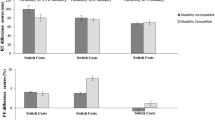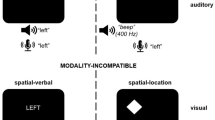Abstract
The present study was aimed at examining modality-specific influences in task switching. To this end, participants switched either between modality compatible tasks (auditory–vocal and visual–manual) or incompatible spatial discrimination tasks (auditory–manual and visual–vocal). In addition, auditory and visual stimuli were presented simultaneously (i.e., bimodally) in each trial, so that selective attention was required to process the task-relevant stimulus. The inclusion of bimodal stimuli enabled us to assess congruence effects as a converging measure of increased between-task interference. The tasks followed a pre-instructed sequence of double alternations (AABB), so that no explicit task cues were required. The results show that switching between two modality incompatible tasks increases both switch costs and congruence effects compared to switching between two modality compatible tasks. The finding of increased congruence effects in modality incompatible tasks supports our explanation in terms of ideomotor “backward” linkages between anticipated response effects and the stimuli that called for this response in the first place. According to this generalized ideomotor idea, the modality match between response effects and stimuli would prime selection of a response in the compatible modality. This priming would cause increased difficulties to ignore the competing stimulus and hence increases the congruence effect. Moreover, performance would be hindered when switching between modality incompatible tasks and facilitated when switching between modality compatible tasks.

Similar content being viewed by others
Notes
The overall error rates of three participants exceeded 20 % (20.9 %; 21.9 %; 25.3 %). Importantly, if these three participants were excluded, the two-way interaction between congruence and modality compatibility was still clearly significant, F(1, 28) = 9.398, p < .01, η 2p = .251, indicating a larger congruence effect in modality incompatible tasks than in compatible tasks (10.4 vs. 6.3 %).
References
Baddeley, A. D. (2003). Working memory: Looking back and looking forward. Nature Reviews Neuroscience, 4, 829–839.
Bruyer, R., & Brysbaert, M. (2011). Combining speed and accuracy in cognitive psychology: is the inverse efficiency score (IES) a better dependent variable than the mean reaction time (RT) and the percentage of errors (PE)? Psychologica Belgica, 51, 5–13.
Greenwald, A. G. (1970). Sensory feedback mechanisms in performance control: with special reference to the ideo-motor mechanism. Psychological Review, 77, 73–99.
Greenwald, A. G. (1972). On doing two things at once: time sharing as a function of ideomotor compatibility. Journal of Experimental Psychology, 94, 52–57.
Hazeltine, E., Ruthruff, E., & Remington, R. W. (2006). The role of input and output modality pairings in dual-task performance: evidence for content-dependent central interference. Cognitive Psychology, 52, 291–345.
Herwig, A., & Waszak, F. (2009). Intention and attention in ideomotor learning. Quarterly Journal of Experimental Psychology, 62, 219–227.
Hirst, W. & Kalmar, D. (1987). Characterizing attentional resources. Journal of Experimental Psychology: General, 116, 68–81. doi:10.1037/0096-3445.116.1.68.
Hughes, M. M., Linck, J. A., Bowles, A. R., Koeth, J. T., & Bunting, M. F. (2014). Alternatives to switch-cost scoring in the task-switching paradigm: Their reliability and increased validity. Behavior Research Methods, in press. doi:10.3758/s13428-013-0411-5.
James, W. (1890). Principles of psychology (Vol. 2, chapter XXVI). New York: Holt.
Johnson, A., & Proctor, R. W. (2004). Attention: Theory and practice. Thousand Oaks, CA: Sage Publications.
Kiesel, A., Steinhauser, M., Wendt, M., Falkenstein, M., Jost, K., Philipp, A. M., & Koch, I. (2010). Control and interference in task switching – A review. Psychological Bulletin, 136, 849–874.
Koch, I. (2009). The role of crosstalk in dual-task performance: Evidence from manipulating response-set overlap. Psychological Research, 73, 417–424. doi:10.1007/s00426-008-0152-8.
Koch, I., & Prinz, W. (2002). Process interference and code overlap in dual-task performance. Journal of Experimental Psychology: Human Perception and Performance, 28, 192–201. doi:10.1037/0096-1523.28.1.192.
Koch, I., Gade, M., Schuch, S., & Philipp, A. M. (2010). The role of inhibition in task switching: a review. Psychonomic Bulletin & Review, 17, 1–14.
Kornblum, S., Hasbroucq, T., & Osman, A. (1990). Dimensional overlap: cognitive basis for stimulus-response compatibility—a model and taxonomy. Psychological Review, 97, 253–270.
Logan, G. D., & Schulkind, M. D. (2000). Parallel memory retrieval in dual-task situations: I. Semantic memory. Journal of Experimental Psychology: Human Perception and Performance, 26, 1072–1090. doi:10.1037/0096-1523.26.3.1072.
Lukas, S., Philipp, A. M., & Koch, I. (2010). Switching attention between modalities: further evidence for visual dominance. Psychological Research, 74, 255–267.
McLeod, P. & Posner, M.I. (1984). Privileged loops from percept to act. In H. Bouma & D. Bowhuis (Eds.), Attention and Performance X (pp. 55–66). Hillsdale: Lawrence Erlbaum Associates.
Meiran, N. (2005). Task rule congruency and Simon-like effects in switching between spatial tasks. Quarterly Journal of Experimental Psychology, 58, 1023–1041.
Monsell, S. (2003). Task switching. Trends in Cognitive Sciences, 7, 134–140.
Navon, D. (1984). Resources—A theoretical soup stone? Psychological Review, 2, 216–234. doi:10.1037/0033-295X.91.2.216.
Navon, D. (1985). Attention division or attention sharing? In M. Posner & M. Marin (Eds.), Attention and Performance XI (pp. 133–146). Hillsdale: Erlbaum.
Navon, D., & Miller, J. (1987). Role of outcome conflict in dual-task interference. Journal of Experimental Psychology: Human Perception and Performance, 13, 435–448. doi:10.1037/0096-1523.13.3.435.
Paelecke, M., & Kunde, W. (2007). Action-effect codes in and before the central bottleneck: evidence from the PRP paradigm. Journal of Experimental Psychology: Human Perception and Performance, 33, 627–644. doi:10.1037/0096-1523.33.3.627.
Pashler, H. (1994). Dual-task interference in simple tasks: data and theory. Psychological Bulletin, 116, 220–244.
Pashler, H. (2000). Task switching and multitask performance. In S. Monsell & J. Driver (Eds.), Attention and Performance XVIII: Control of Cognitive Processes (pp. 277–307). Cambridge: MIT Press.
Prinz, W. (1997). Perception and action planning. European Journal of Cognitive Psychology, 9, 129–154.
Proctor, R. W., & Vu, K.-P. L. (2006). Stimulus-response compatibility principles: Data, theory, and practice. Boca-Raton, FL: Taylor & Francis.
Proctor, R. W., & Wang, H. (1997). Set- and element-level stimulus–response compatibility effects for different manual response sets. Journal of Motor Behavior, 29, 351–365.
Rogers, R. D., & Monsell, S. (1995). Costs of a predictable switch between simple cognitive tasks. Journal of Experimental Psychology: General, 124, 207–231.
Shin, Y. K., Proctor, R. W., & Capaldi, E. J. (2010). A review of contemporary ideomotor theory. Psychological Bulletin, 136, 943–947.
Spijkers, W., Heuer, H., Steglich, C., & Kleinsorge, T. (2000). Specification of movement amplitudes fort he left and right hands: Evidence for transient parametric coupling from overlapping-task performance. Journal of Experimental Psychology: Human Perception and Performance, 26, 1091–1101. doi:10.1037/0096-1523.26.3.1091
Stelzel, C., Schumacher, E. H., Schubert, T., & D`Esposito, M. (2006). The neural effect of stimulus-response modality compatibility in dual-task performance: an fMRI study. Psychological Research, 70, 514–525.
Stephan, D. N., & Koch, I. (2010). Central cross-talk in task switching: evidence from manipulating input-output modality compatibility. Journal of Experimental Psychology. Learning, Memory, and Cognition, 36, 1075–1081.
Stephan, D. N., & Koch, I. (2011). The role of input-output modality compatibility in task switching. Psychological Research, 75, 491–498.
Stephan, D.N., & Koch, I. (2015). Tactile stimuli increase effects of modality compatibility in task switching. Experimental Psychology. in press.
Townsend, J. T., & Ashby, F. G. (1983). Stochastic modeling of elementary psychological processes. Cambridge: Cambridge University Press.
Vandierendonck, A., Liefooghe, B., & Verbruggen, F. (2010). Task switching: interplay of reconfiguration and interference. Psychological Bulletin, 136, 601–626.
Virzi, R. A., & Egeth, H. E. (1985). Toward a translational model of Stroop interference. Memory & Cognition, 13, 304–319.
Wang, H., & Proctor, R. W. (1996). Stimulus–response compatibility as a function of stimulus code and response modality. Journal of Experimental Psychology: Human Perception and Performance, 22, 1201–1217.
Wickens, C. D. (1984). Processing resources in attention. In R. Parasuraman & D. R. Davies (Eds.), Varieties of attention (pp. 63–102). New York: Academic Press.
Acknowledgments
The authors would like to thank the action editor Wilfried Kunde, as well as Eric Ruthruff and an anonymous reviewer for their helpful comments on the earlier version of this manuscript. The present research was funded by the Deutsche Forschungsgemeinschaft (KO2045/9-1).
Author information
Authors and Affiliations
Corresponding author
Rights and permissions
About this article
Cite this article
Stephan, D.N., Koch, I. Modality-specific effects on crosstalk in task switching: evidence from modality compatibility using bimodal stimulation. Psychological Research 80, 935–943 (2016). https://doi.org/10.1007/s00426-015-0700-y
Received:
Accepted:
Published:
Issue Date:
DOI: https://doi.org/10.1007/s00426-015-0700-y




